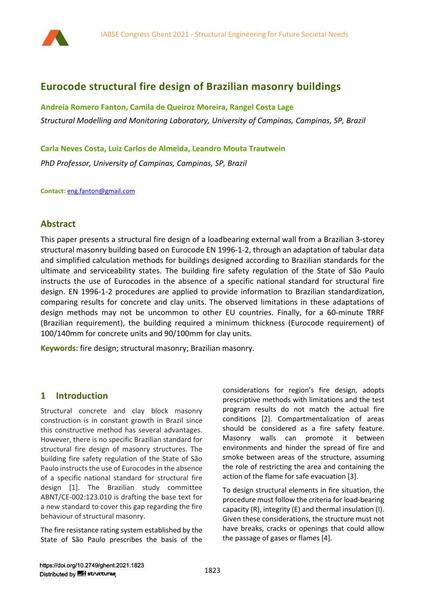Eurocode structural fire design of Brazilian masonry buildings

|
|
|||||||||||
Bibliographic Details
| Author(s): |
Andreia Romero Fanton
(Structural Modelling and Monitoring Laboratory, University of Campinas, Campinas, SP, Brazil)
Camila de Queiroz Moreira (Structural Modelling and Monitoring Laboratory, University of Campinas, Campinas, SP, Brazil) Rangel Costa Lage (Structural Modelling and Monitoring Laboratory, University of Campinas, Campinas, SP, Brazil) Carla Neves Costa (Structural Modelling and Monitoring Laboratory, University of Campinas, Campinas, SP, Brazil) Luiz Carlos de Almeida (PhD Professor, University of Campinas, Campinas, SP, Brazil) Leandro Mouta Trautwein (PhD Professor, University of Campinas, Campinas, SP, Brazil) |
||||
|---|---|---|---|---|---|
| Medium: | conference paper | ||||
| Language(s): | English | ||||
| Conference: | IABSE Congress: Structural Engineering for Future Societal Needs, Ghent, Belgium, 22-24 September 2021 | ||||
| Published in: | IABSE Congress Ghent 2021 | ||||
|
|||||
| Page(s): | 1823-1830 | ||||
| Total no. of pages: | 8 | ||||
| DOI: | 10.2749/ghent.2021.1823 | ||||
| Abstract: |
This paper presents a structural fire design of a loadbearing external wall from a Brazilian 3-storey structural masonry building based on Eurocode EN 1996-1-2, through an adaptation of tabular data and simplified calculation methods for buildings designed according to Brazilian standards for the ultimate and serviceability states. The building fire safety regulation of the State of São Paulo instructs the use of Eurocodes in the absence of a specific national standard for structural fire design. EN 1996-1-2 procedures are applied to provide information to Brazilian standardization, comparing results for concrete and clay units. The observed limitations in these adaptations of design methods may not be uncommon to other EU countries. Finally, for a 60-minute TRRF (Brazilian requirement), the building required a minimum thickness (Eurocode requirement) of 100/140mm for concrete units and 90/100mm for clay units. |
||||
| Keywords: |
fire design structural masonry Brazilian masonry
|
||||
| Copyright: | © 2021 International Association for Bridge and Structural Engineering (IABSE) | ||||
| License: | This creative work is copyrighted material and may not be used without explicit approval by the author and/or copyright owner. |
||||
